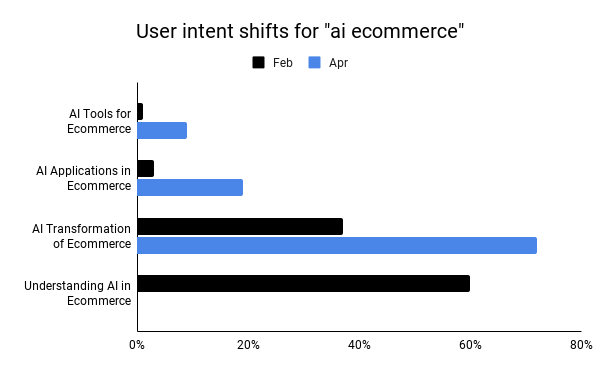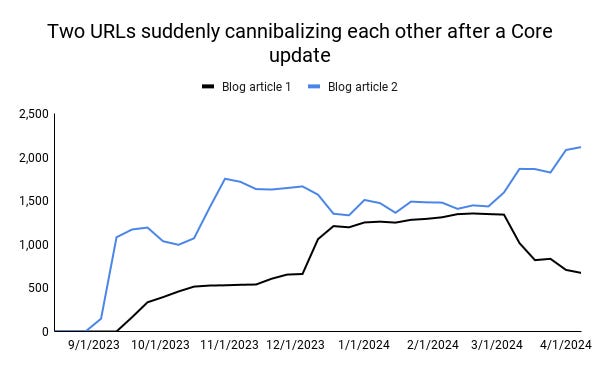Boost your skills with Growth Memo’s weekly expert insights. Subscribe for free!
Sites can lose significant organic traffic from Core Updates without obvious patterns when analyzing rank changes. One hidden cause is subtle intent shifts.
Two outdated models prevent us from seeing what’s really going on.
One, we often think of user intent as transactional, navigational, informational, and commercial. But today, user intent is much more refined and specific.
Two, not all spots in the search results are the same. Google splits the top results into dominant, common, and minor intent.
Unless we’re talking about long-tail keywords with a very clear intent, keywords can have several meanings. Some people searching for “ai ecommerce,” for example, want to know how AI is used in ecommerce, while others want to know how ecommerce changes due to AI. Subtle but different.
As a result, Google shows a mix of results trying to answer each of those intents as good as possible.
Google reranks search results during Core Updates when it detects user intent shifts, which can be especially hardcore when dominant intent and the top 3 results are affected.
In the grand scheme of things, small rank changes often seem minuscule and chaotic. But what we’re seeing is the Butterfly Effect: a small change making a massive impact.
 Image Credit: Lyna ™
Image Credit: Lyna ™Butterfly Effects From Intent Shifts
Without knowing what to look for, it’s hard to detect and understand subtle rank changes due to user intent shifts (Butterfly Effects).
Our understanding of keyword meaning is often too static. Topics change all the time.
On one end of the spectrum, you have news-related keywords that fall into query deserves freshness (QDF) filters. Look at the news for a day and you see the peak of how fast the meaning of a keyword can change.
On the other end, you have evergreen keywords that barely change in meaning.
Take the example “ecommerce ai.” Between early February and mid-April, the dominant user intent changed from “information about AI in ecommerce” to “how ai transforms the ecommerce industry.”
 Image Credit: Kevin Indig
Image Credit: Kevin IndigIn the screenshot below, I color-coded the different types of intent to highlight how subtle the differences can be.
 Image Credit: Kevin Indig
Image Credit: Kevin IndigIt makes sense. AI changes rapidly, and so does its impact. People learn about it and come up with more questions. When (dominant) user intent changes, ranks follow suit.
The weighting of intents shown in the SERPs for keywords can also change. A dominant user intent can become a common one and a common minor one.
Intent shifts are the reason why Google says that not always are site owners doing something wrong when an update rolls out, and that there is “nothing to fix” and that you cannot “recover” from an algorithm update. Well.
An even bigger challenge arises when intent shifts and two URLs suddenly cannibalize each other.
For example, when an article covers an introduction to a topic (“what is…”) and another covers a more comprehensive guide to the topic, they can both rank at the same time or suddenly compete.
 Image Credit: Kevin Indig
Image Credit: Kevin IndigHow do you find Butterfly Effects? When organic traffic drops after a Core Update, pay attention to keywords that dropped out of the top 3 positions. This is where it hurts the most. Even a single position drop has an outsized impact.
To quantify intent shifts, you can analyze the titles of results ranking before and after the update. Titles are not the end-all-be-all, but they give important clues about user intent.
At scale, you can use your LLM of choice to categorize titles with prompts like:
- “Cluster the following titles into one of the following groups: {intent 1}, {intent 2}, {intent 3}, etc.”
- “What intention could users have when clicking on the following search result?”
For very popular queries, we can take it a step further and analyze the trend of searches in Google Suggest to see if search volume is growing or shrinking.
Rapidly rising search demand for a related keyword could alter the dominant, common, or minor search intent for the root keyword.
Note that we don’t know all keywords with growing search volume or where Google’s threshold is for determining that user intent for keyword shifts. There is a time factor present as well since some keywords rapidly change their meaning (think “Independence Day” and “Wuhan”).
How to act on intent shifts? Once you’ve identified that intent has shifted for a keyword, you have three options:
- Fix potential cannibalization (delete or consolidate).
- Rewrite affected articles to match new user intent.
- Create new content based on changed user intent.
Core Updates Are Multi-Faceted
Refining user intent is not all that Core Updates do. They’ve become kitchen sinks for all sorts of systems:
- The Helpful Content classier has been integrated with Core Updates (link).
- Other quality systems like Panda and Penguin have been integrated with Core Updates years ago.
- 15% of searches Google gets are net new, which means Google needs to test the initial results mix and iterate based on user signals.
All of these influences make Core Updates multi-faceted, complex, and unpredictable. However, considering the different forms of user intent and subtle changes gives us a path to move from confusion to problem-solution.
Featured Image: Paulo Bobita/Search Engine Journal

